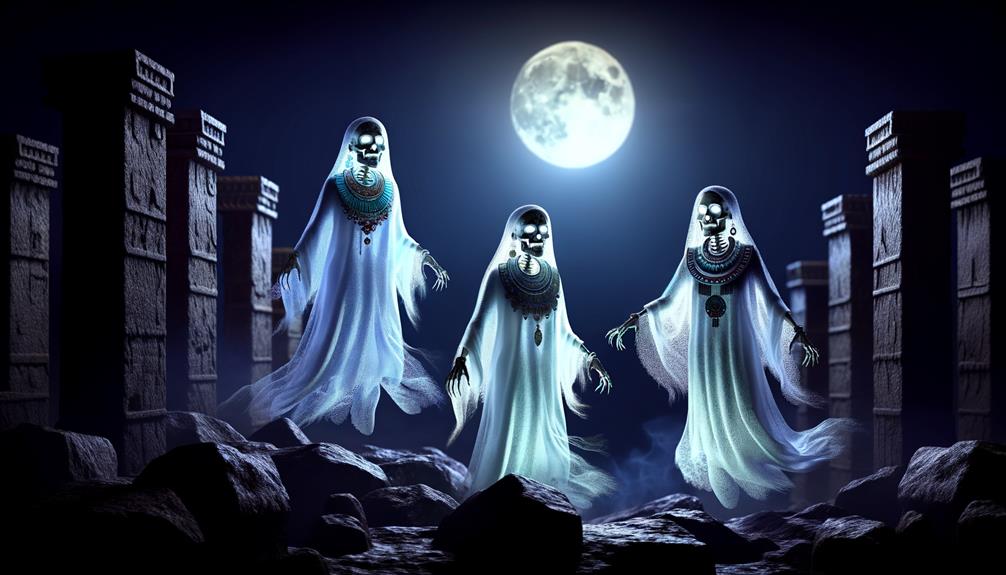In the lore of the Aztecs, the Cihuateteo are feared female spirits, representing women who lost their lives during childbirth. They have a reputation for causing havoc and spreading fear, particularly at intersections. It's said these spirits can bring about sickness, paralysis, and even possession. To try and keep them at bay, the Aztecs often made particular offerings. The Cihuateteo are easy to spot, thanks to their skeletal faces and claw-like hands, making them prominent figures in Aztec traditions and ceremonies. Studying their impact and the legends that surround them offers an intricate look into the complexities of the Aztec world.
Origin of Cihuateteo in Aztec Mythology
Let's take a look at the story of the Cihuateteo in Aztec mythology. These are the spirits of women who, sadly, didn't survive childbirth, a tragic backstory that might explain why they're known to stir up trouble at crossroads on certain feast days. It's not that they're friendly ghosts, quite the opposite – they're known to cause a good deal of mischief and terror.
Remember those scary stories parents tell their kids to keep them in check? Well, in Aztec culture, the tale of the Cihuateteo served a similar purpose. Kids were told to stay inside during certain nights to avoid encountering these spirits, who were believed to bring illness, paralysis, and even possession. This wasn't just a scary story, it was a deeply held belief in Aztec culture.
To keep these angry spirits happy, the Aztecs would make offerings. They often left out bread, tamales, and corn hoping that these gifts would keep the Cihuateteo satisfied, and in turn, keep their community safe. This practice showcases how the tragic story of the Cihuateteo – women who didn't make it through childbirth – had a big influence on Aztec rituals and beliefs, underlining the significant impact these spirits had on Aztec society.
Symbolism and Representation of Cihuateteo
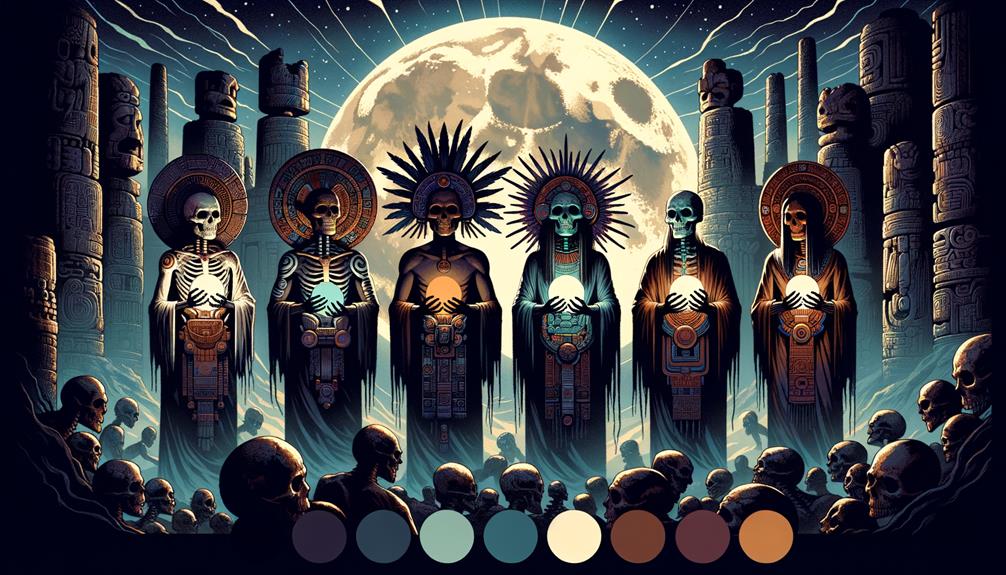
If we take a closer look at the symbolism and representation of Cihuateteo, we see that these spirits symbolize women who sadly lost their lives during childbirth and have transformed into powerful warriors according to Aztec mythology. The Aztecs looked upon these women as brave warriors, a testament to their respect for the struggles and risks involved in childbirth.
The Cihuateteo are represented in various symbolic ways:
- Their skeletal faces and clawed hands are symbolic of death and their fierce spirit.
- Their association with the sun's movement in the western domain represents the journey of the sun and the warriors into the underworld.
- They're often seen at spooky crossroads on certain feast days, showing their connection with in-between spaces, as crossroads are traditionally considered places where the barrier between worlds is thin.
- Gifts of bread, tamales, and corn given to them highlight the Aztecs' attempts to keep these powerful spirits in good humor and ward off their harmful influence.
These symbols show that the Cihuateteo symbolize the sad transformation of women into warriors, the sun's journey, the thin barrier between worlds at crossroads, and the Aztec's strategies to deal with these powerful spirits.
Cihuateteos Influence on Aztec Society
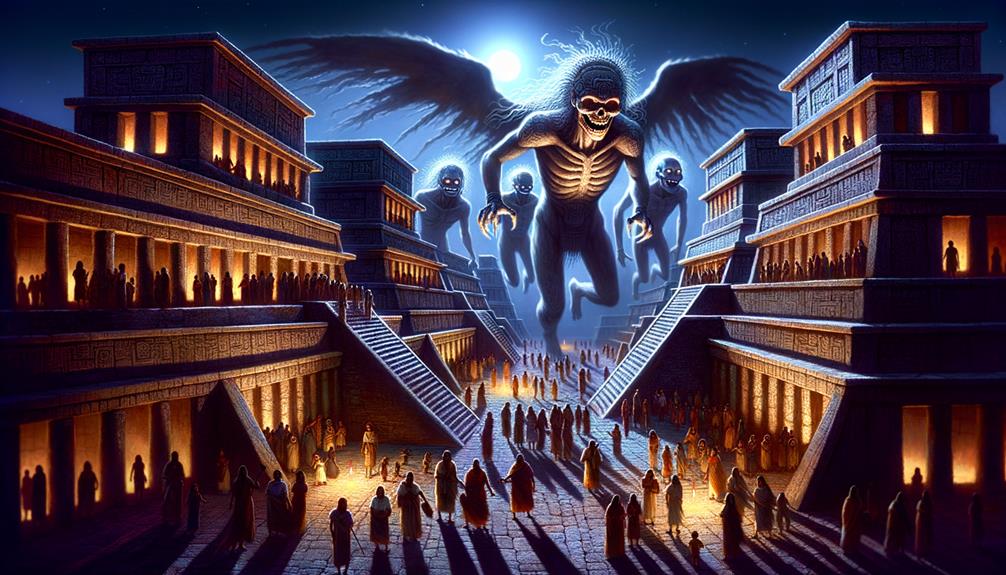
If we're chatting about Aztec society, it's impossible not to mention the significant effect of Cihuateteo. These were the ghostly spirits of women who, sadly, didn't survive childbirth. Known for their somewhat chilling presence at crossroads during certain festivals, these female spirits were notorious for causing illness, paralysis and, in more extreme cases, possession. Their influence was so strong that many parents would advise their children to stay indoors on nights associated with these spirits.
Aztecs came up with certain rituals to calm the Cihuateteo. Offerings like bread, tamales, and corn were made with the hope of soothing these spirits. This act was a clear indication of both respect and fear for these deified spirits. This sense of reverence was also evident in the detailed depictions of Cihuateteo, represented with ghostly pale faces and chalk-white limbs, symbolizing their connection with childbirth and the journey of the sun.
Let's not forget about the goddess Cihuacoatl, who also had a connection with these spirits. Known as the goddess of motherhood and fertility, she was believed to have Cihuateteo as her assistants. This connection further emphasized the importance of these spirits in Aztec society. Cihuateteo were seen as protectors of women who died during childbirth, and they also prevented the theft of relics. This shows how deeply integrated they were into the day-to-day life of this ancient civilization.
Rituals and Traditions Associated With Cihuateteo
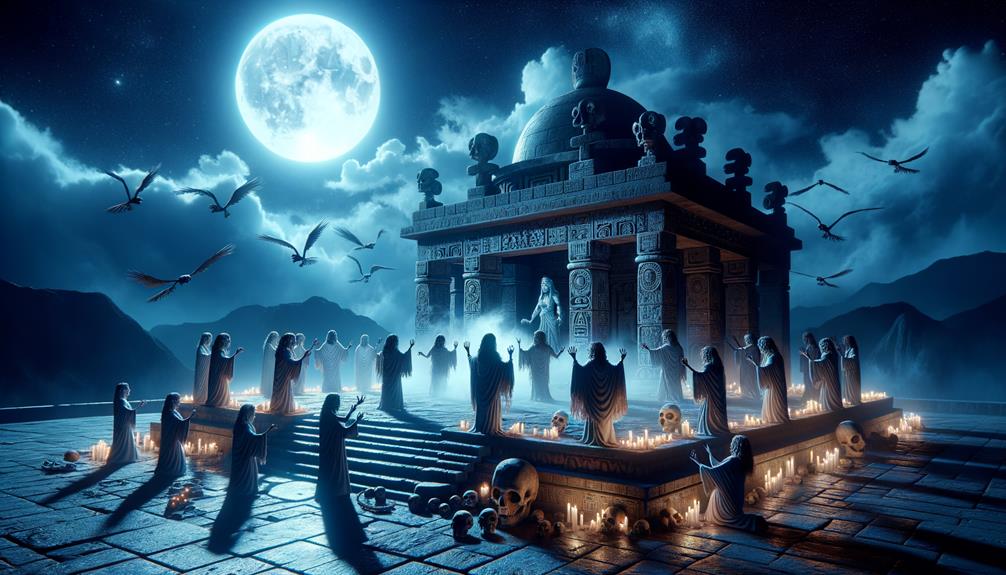
Let's turn our attention from the central role of Cihuateteo in Aztec society and focus on the rituals and traditions intricately tied to these fearsome female spirits. The Aztecs held a deep respect for these spirits, who they believed were fallen childbirth warriors. This reverence featured prominently in a variety of Aztec rituals and customs.
- They would make offerings of bread, tamales, and corn in a bid to appease these spirits, a gesture that showed the Aztecs' recognition of their potential fury and their wish to keep the peace.
- Special feast days were set aside for the Cihuateteo. On these days, the community would avoid certain activities, and children were specifically advised to stay inside to avoid being possessed.
- The Cihuateteo were thought to have the power to cause illness and paralysis, underlining the deep fear these spirits inspired.
- The Aztecs viewed crossroads as spooky places during certain times, necessitating measures to protect against the Cihuateteo's eerie presence.
Modern Interpretations of Cihuateteo
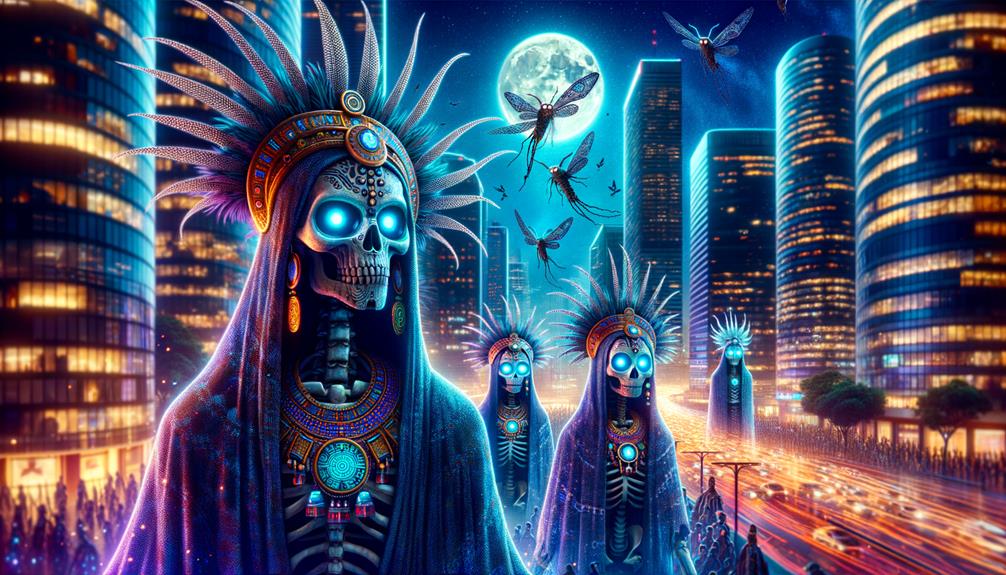
In today's world, we see the Cihuateteo, not just as scary spirits, but as powerful symbols of women's strength and resilience in the face of childbirth. The shift from fear to respect shows our recognition of the courage needed to deal with the uncertainties of motherhood and life itself.
Artists of today often portray Cihuateteo as figures of motherly sacrifice and spiritual toughness. These expressions question the old stories, giving us a deeper appreciation of the intricate details in Aztec mythology. Through such portrayals, the Cihuateteo rise above their scary beginnings, turning into multifaceted characters that embody the two sides of life and death.
Modern-day researchers dig deeper into the intricate patterns of Aztec beliefs, studying the Cihuateteo as icons of divine femininity. They emphasize their role as middlemen between life and death, underlining how these ideas are tied together in the spiritual world. Through such academic discussions, the Cihuateteo keep fuelling a wider understanding of gender, spirituality, and the ongoing impact of Aztec mythology.
In a nutshell, today's interpretations of Cihuateteo are a salute to the unending strength and grit of women, even when faced with the reality of life's end.
Frequently Asked Questions
What Is Cihuateteo the God Of?
In the lore of the Aztecs, Cihuateteo isn't considered a deity. Rather, they're spirits of women who tragically lost their lives while giving birth. These spirits are revered for their daily task of guiding the sun from its zenith until it sets. Additionally, they're known to frequent crossroads during certain celebrations.
Who Is the Aztec Star Goddess?
The Aztec Star Goddess, known as Citlalicue, is pretty fascinating. She's like the embodiment of the Milky Way, which is really cool. The Aztecs believed she was all about birth, transformation, and the cycle of life and death. She's often tied to stories about fertility, which makes sense when you think about it. What's really interesting is that she's seen as a symbol of how the celestial and earthly worlds come together in Aztec beliefs. It's a pretty amazing mix of astronomy, mythology, and spirituality when you stop to think about it.
Who Is the Aztec Goddess of Healing?
You know, it's fascinating to dive into Aztec mythology. Take Tlazolteotl, for instance. She's the Aztec goddess of healing. But her role doesn't stop there. She's also seen as a purifier and a fertility deity. Her symbolism? Renewal and transformation. If you were looking for spiritual rejuvenation in the Aztec world, she'd be your guide. Quite intriguing, isn't it?
Who Is the Aztec Goddess of Midwife?
Let's chat about Aztec mythology for a bit. There's this goddess, Cihuacoatl, who's pretty well-known for her connection to midwives and motherhood. She's kind of a big deal when it comes to fertility and creating life. So, you can imagine how she's a key character when it comes to the Aztec perspective on childbirth.

